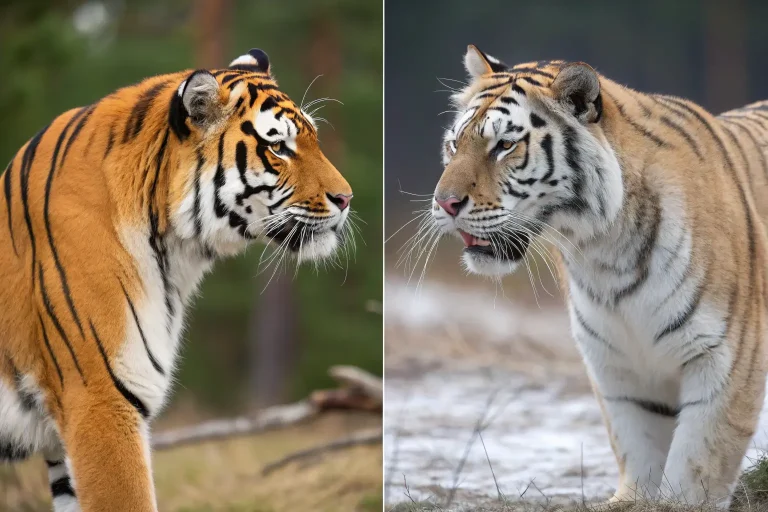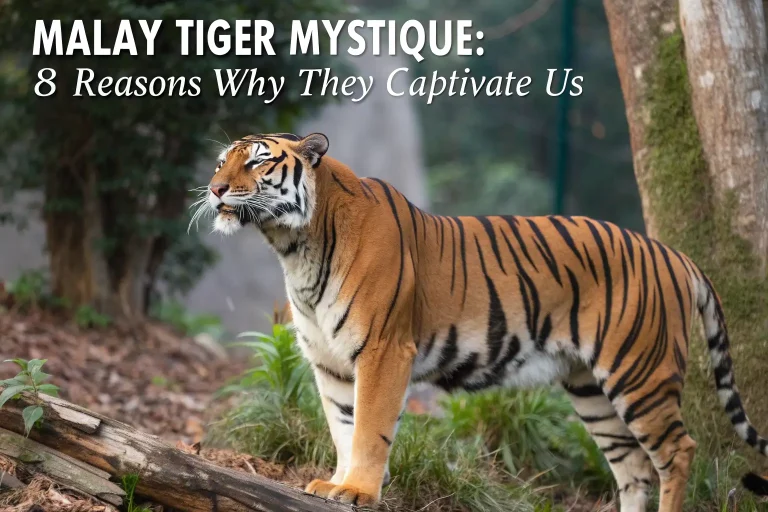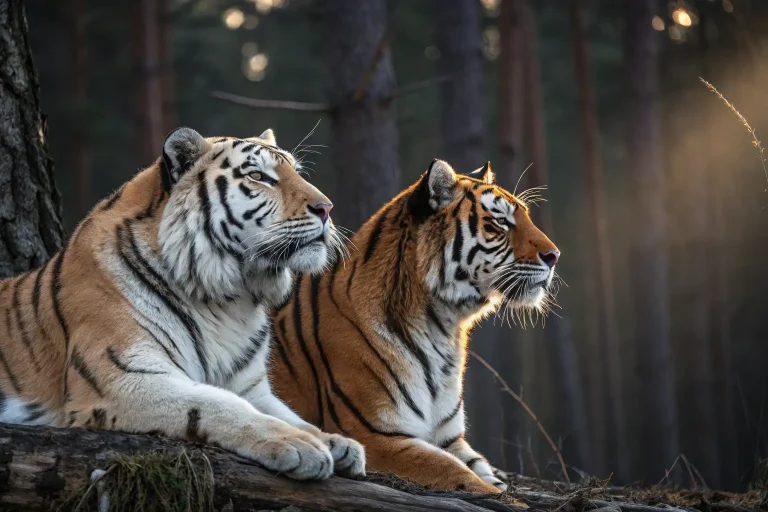Siberian Tiger vs Bengal Tiger: 7 Key Differences Explained
Are you fascinated by the world’s most magnificent big cats? The eternal debate of Siberian tiger vs Bengal tiger has captivated wildlife enthusiasts for generations. These apex predators, while sharing the same species classification, exhibit remarkable differences that have evolved through adaptation to vastly different environments. Whether you’re a wildlife enthusiast, a conservation advocate, or simply curious about these majestic creatures, understanding what sets these tigers apart reveals fascinating insights into nature’s diversity and evolutionary prowess.
Introduction
Tigers, the largest members of the cat family, command respect and awe wherever they’re found. The Siberian tiger and Bengal tiger stand as the two most recognized subspecies, each claiming unique territories, physical attributes, and survival adaptations. Their distinctions go far beyond mere geographical separation, extending into virtually every aspect of their biology and behavior.
When comparing the Siberian tiger vs Bengal tiger, we’re examining two evolutionary marvels that have adapted to dramatically different climates and landscapes. The freezing taiga forests of Russia shaped one, while the sweltering jungles of India molded the other. This environmental contrast has produced fascinating differences that we’ll explore throughout this comprehensive comparison.
Perhaps most surprising is how these differences have emerged despite both animals belonging to the same species—a testament to nature’s remarkable ability to customize life forms to specific ecological niches.
Species Overview
Scientific Classification
Both the Siberian tiger and Bengal tiger belong to the same species, Panthera tigris. However, they’re classified as different subspecies:
- Siberian Tiger: Panthera tigris altaica (also called Amur tiger)
- Bengal Tiger: Panthera tigris tigris
These taxonomic distinctions reflect their evolutionary divergence as they adapted to different geographical regions and environmental conditions.
Physical Characteristics
The Siberian tiger vs Bengal tiger size difference is one of the most noticeable distinctions. Siberian tigers are generally larger:
Siberian Tigers:
- Males typically weigh 400-675 pounds (180-306 kg)
- Can reach lengths of 10-12 feet (3-3.7 meters)
- Stand about 3-3.5 feet (0.9-1.1 meters) at the shoulder
- Feature thicker, longer fur with paler orange coloration and fewer stripes
- Have fuller facial ruff and mane-like fur around the neck
Bengal Tigers:
- Males typically weigh 350-550 pounds (159-249 kg)
- Reach lengths of 8-10 feet (2.4-3 meters)
- Stand approximately 3 feet (0.9 meters) at the shoulder
- Display vibrant orange coat with well-defined black stripes
- Possess sleeker, shorter fur with less pronounced facial features
The Siberian’s bulkier build and thick coat make it appear substantially more massive, following Bergmann’s rule that animals in colder climates evolve larger bodies to conserve heat.
Subspecies Variations
While we’re focusing on the Siberian and Bengal subspecies, it’s worth noting that tigers once comprised nine distinct subspecies. Sadly, three have gone extinct (Bali, Javan, and Caspian tigers), and the remaining six face various levels of endangerment:
- Siberian/Amur tiger (P. t. altaica)
- Bengal tiger (P. t. tigris)
- Indochinese tiger (P. t. corbetti)
- Malayan tiger (P. t. jacksoni)
- South China tiger (P. t. amoyensis)
- Sumatran tiger (P. t. sumatrae)
Each subspecies developed unique adaptations to their specific environments, with the Siberian and Bengal tigers representing the extremes in size and habitat adaptation.
Habitat and Distribution
Natural Habitat
The dramatic contrast in the environments where these tigers evolved accounts for many of their differences:
Siberian Tigers:
- Thrive in the boreal forests (taiga) of eastern Russia
- Adapted to extreme cold with temperatures dropping to -50°F (-45°C)
- Navigate snowy, mountainous terrain and dense coniferous forests
- Require vast territories due to lower prey density
Bengal Tigers:
- Inhabit tropical and subtropical forests, mangrove swamps, and grasslands
- Adapted to hot, humid climates with temperatures often exceeding 104°F (40°C)
- Often found near water sources in varied terrain from lowland areas to foothills
- Maintain smaller territories due to higher prey density
Geographic Range
The Siberian tiger vs Bengal tiger distribution shows minimal overlap:
Siberian Tigers:
- Primarily found in Russia’s Far East (Primorye and Khabarovsk regions)
- Small populations may exist in northern China and possibly North Korea
- Historically ranged across much of northern China, Korean Peninsula, and eastern Russia
- Current wild population estimated at 500-550 individuals
Bengal Tigers:
- Mainly found in India (which hosts about 70% of the global tiger population)
- Also present in Bangladesh, Nepal, and Bhutan
- Formerly widespread across Pakistan and Myanmar
- Current wild population estimated at 2,500-3,000 individuals
Adaptations
The Siberian tiger vs Bengal tiger comparison reveals remarkable adaptations to their respective environments:
Siberian Tigers:
- Developed thick, pale fur with an insulating fat layer up to 2 inches (5 cm) thick
- Broader paws that function like snowshoes in deep snow
- Denser fur around face and paws for cold protection
- Larger body size to maintain heat conservation
- Longer, thicker whiskers to navigate in blizzard conditions
Bengal Tigers:
- Evolved sleeker bodies that dissipate heat more efficiently
- Shorter, more vibrant fur that provides better camouflage in dappled jungle light
- Smaller paws proportional to body weight for faster acceleration
- Strong swimming abilities for cooling and hunting in wetland habitats
- More pronounced markings to blend with shifting light patterns in dense forests
These adaptations showcase nature’s precision in tailoring each subspecies to maximize survival in their respective environments.
Diet and Feeding Habits
What They Eat
Both tiger subspecies are obligate carnivores, but their prey preferences reflect local availability:
Siberian Tigers:
- Primary prey: elk, wild boar, sika deer, and Manchurian moose
- Secondary prey: brown bears, Asiatic black bears, lynx, and wolves
- Will hunt smaller animals like rabbits and salmon when larger prey is scarce
- Adaptable diet necessary due to seasonal prey fluctuations in harsh climate
Bengal Tigers:
- Primary prey: spotted deer, sambar deer, wild boar, and water buffalo
- Secondary prey: gaur, nilgai antelope, langur monkeys, and porcupines
- Occasionally take livestock including cattle and goats
- More consistent year-round prey availability in tropical environments
Hunting Behavior
The Siberian tiger vs Bengal tiger hunting techniques show subtle but important differences:
Siberian Tigers:
- Travel greater distances while hunting (up to 60 miles/100 km in a day)
- Often track prey for hours before ambushing
- More likely to hunt in daylight hours during winter
- Can bring down prey significantly larger than themselves
- Need to consume more calories to maintain body temperature in cold
Bengal Tigers:
- Hunt primarily at night and dawn/dusk hours
- Rely heavily on stealth in dense vegetation
- Excellent swimmers who often hunt near water
- Use water to ambush prey coming to drink
- Generally stalk within 20-50 feet before launching attack
Dietary Needs
Despite their habitat differences, both subspecies share similar nutritional requirements:
- Adult tigers consume 10-25 pounds (4.5-11 kg) of meat daily when feeding
- Both typically go several days between meals after a large kill
- Siberian tigers generally require higher caloric intake during winter months
- Bengal tigers may fast during extreme heat periods
- Both can consume up to 60 pounds (27 kg) of meat in a single feeding
Interestingly, the Siberian tiger vs Bengal tiger comparison reveals that Siberians must build fat reserves before winter, while Bengals maintain more consistent body weight year-round.
Behavior and Social Structure
Social Behavior
Both subspecies are predominantly solitary, but with subtle variations:
Siberian Tigers:
- Maintain larger territories (250-450 square miles/650-1,165 square km for males)
- Less territorial overlap between individuals due to scarcer resources
- More strict avoidance of other tigers except during mating
- Females may allow subadult offspring to remain longer due to harsh conditions
Bengal Tigers:
- Smaller territories (40-75 square miles/103-194 square km for males)
- Greater tolerance for territorial overlap, especially near abundant water sources
- More frequent indirect interaction through scent marking
- Occasionally show temporary social tolerance at large kills
Communication
The Siberian tiger vs Bengal tiger communication methods include:
Siberian Tigers:
- Vocalizations carry farther in the less dense taiga environment
- More pronounced long-distance roaring patterns
- Extensive use of scent marking along game trails
- Snow allows more visible tracking of other tigers
Bengal Tigers:
- Higher frequency of visual territorial marking
- More complex vocal repertoire documented in tropical forests
- Heavy reliance on scrape marks and urine spraying on vegetation
- Utilize seasonal flooding to reset and establish territories
Both subspecies share communication tools including chuffs, growls, roars, and various body postures, though they may employ them with different frequencies.
Mating and Reproduction
Reproductive strategies show another fascinating aspect of the Siberian tiger vs Bengal tiger comparison:
Siberian Tigers:
- Breeding typically occurs January-June
- Females produce smaller litters (2-3 cubs) but with larger cubs
- Longer maternal care period, often 2-3 years
- Cubs born with thicker fur for cold protection
- Sexual maturity reached around 4-5 years
Bengal Tigers:
- Can breed year-round, but most frequently November-April
- Typically produce 2-4 cubs per litter
- Cubs become independent at 18-24 months
- Higher cub mortality but potentially more frequent reproduction
- Sexual maturity reached around 3-4 years
These reproductive differences reflect their environmental adaptations, with Siberian tigers investing more in fewer, hardier offspring while Bengal tigers produce more cubs with higher turnover.
Conservation Status

Endangerment Level
Both subspecies face serious threats, though their conservation statuses differ slightly:
Siberian Tigers:
- Listed as Endangered on the IUCN Red List
- Population has stabilized at approximately 500-550 individuals
- Showing signs of recovery from historical low of 40 tigers in the 1940s
- Genetic bottleneck remains a serious concern
Bengal Tigers:
- Listed as Endangered on the IUCN Red List
- Population estimated at 2,500-3,000 individuals
- India’s tiger population has increased by 33% since 2014
- Highly fragmented subpopulations threaten genetic diversity
Threats
Both subspecies face similar threats, though with regional variations:
Siberian Tigers:
- Poaching for traditional Asian medicine remains the primary threat
- Habitat loss due to logging and resource extraction
- Prey depletion from illegal hunting
- Human-tiger conflict in areas of expansion
- Climate change affecting taiga forest composition
Bengal Tigers:
- Habitat fragmentation due to human population growth
- Poaching for skins, bones, and other body parts
- Retaliatory killing due to livestock predation
- Infrastructure development cutting through corridors
- Loss of genetic diversity in isolated populations
Conservation Efforts
Conservation strategies for both subspecies focus on similar approaches but implementation differs:
Siberian Tigers:
- Russia’s Sikhote-Alin Reserve and other protected areas
- International cooperation between Russia, China, and North Korea
- Anti-poaching brigades in key habitats
- Reintroduction programs in historical ranges
- Genetic management to address inbreeding concerns
Bengal Tigers:
- India’s Project Tiger reserves network
- Tiger corridor connectivity projects
- Community-based conservation initiatives
- Compensation programs for livestock loss
- Advanced monitoring using camera traps and DNA analysis
The survival of both subspecies demands global cooperation, though the Siberian tiger vs Bengal tiger conservation approach must address their unique ecological needs.
Interesting Facts
The Siberian tiger vs Bengal tiger comparison yields fascinating facts:
Siberian tigers can leap up to 32 feet (10 meters) horizontally and 12 feet (3.7 meters) vertically, despite their larger size.
Bengal tigers in the Sundarbans mangrove forests are excellent swimmers who have developed a tolerance for saltwater and can swim several kilometers between islands.
Rare white tigers almost exclusively occur in the Bengal tiger population due to a recessive gene. They are not albinos but have reduced pigmentation.
Siberian tigers can differentiate between the front and back paws of prey animals in the snow, allowing them to determine which direction the animal was traveling.
A Bengal tiger’s roar can be heard up to 2 miles (3 km) away and can paralyze prey with fear.
Siberian tigers have been documented killing brown bears weighing up to 1,200 pounds (544 kg)—more than twice their own weight.
Bengal tigers each have a unique stripe pattern, like human fingerprints, allowing researchers to identify individuals.
Siberian tigers’ paws can expand to 8 inches (20 cm) across when walking on snow.
Some Bengal tigers in Nepal have been documented living at elevations up to 13,000 feet (4,000 meters).
Despite their fierce reputation, both subspecies spend about 18-20 hours of their day resting and sleeping.
Role in the Ecosystem
Ecological Importance
As apex predators, both tiger subspecies play crucial ecological roles:
Siberian Tigers:
- Control ungulate populations, preventing overbrowsing of vegetation
- Influence prey behavior, creating “landscapes of fear” that affect forest regeneration
- Remove sick and weak individuals from prey populations
- Their kills provide food for scavengers in nutrient-poor boreal environments
- Help maintain biodiversity through trophic cascades
Bengal Tigers:
- Regulate prey species that might otherwise degrade habitats through overgrazing
- Create ecological balance in complex tropical ecosystems
- Their presence indicates healthy, intact ecosystems
- Influence prey distribution patterns, indirectly affecting vegetation structure
- Their protection leads to conservation of entire landscapes
Impact of Decline
The loss of either subspecies would have profound consequences:
- Unchecked herbivore populations would alter vegetation structure and composition
- Mesopredator release effects—smaller predators would increase, affecting smaller prey species
- Loss of ecotourism value that currently incentivizes habitat protection
- Reduced genetic diversity within the overall tiger species
- Cultural and symbolic losses for human societies that revere tigers
The Siberian tiger vs Bengal tiger ecological roles, while similar, maintain balance in vastly different ecosystems, making both irreplaceable components of their respective environments.
Conclusion
The Siberian tiger vs Bengal tiger comparison reveals nature’s incredible adaptability. These magnificent creatures, though belonging to the same species, have evolved distinct characteristics that perfectly suit their respective environments. From the Siberian’s thick coat and massive build designed for cold survival to the Bengal’s sleeker form adapted for tropical heat, these differences reflect the pinnacle of evolutionary specialization.
Both subspecies face serious threats in the modern world, and their conservation represents more than just saving individual animals—it’s about preserving ecological balance, biodiversity, and cultural heritage. The story of these tigers reminds us that protection must be tailored to each subspecies’ unique needs.
As we consider which tiger might be “mightier,” the answer isn’t straightforward. The Siberian’s size advantage is countered by the Bengal’s speed and agility. Perhaps the true measure of might lies in their remarkable resilience against overwhelming odds and their continued survival despite centuries of persecution.
What can you do to help? Supporting conservation organizations, avoiding products made from tiger parts, raising awareness, and promoting sustainable practices all contribute to ensuring these magnificent animals survive for future generations. The fate of these apex predators ultimately rests in human hands.
Frequently Asked Questions
Which is bigger, the Siberian tiger or Bengal tiger?
The Siberian tiger is generally larger than the Bengal tiger. Male Siberians typically weigh 400-675 pounds (180-306 kg) compared to male Bengals at 350-550 pounds (159-249 kg). Siberians also have longer bodies and thicker limbs due to their cold-climate adaptations.
Could a Siberian tiger survive in a Bengal tiger’s habitat?
A Siberian tiger would struggle in tropical environments as their thick fur and fat layer would cause overheating. They evolved specifically for cold climates and lack the heat-regulation adaptations of Bengal tigers. Conversely, Bengal tigers would have difficulty surviving Siberian winters without sufficient insulation.
Which subspecies is more endangered?
Both are endangered, but Siberian tigers face a more precarious situation with only 500-550 individuals remaining in the wild compared to 2,500-3,000 Bengal tigers. However, the Bengal tiger population is more fragmented, which presents its own conservation challenges.
Do Siberian and Bengal tigers ever encounter each other in the wild?
No, these subspecies have completely separate geographical ranges separated by thousands of miles and significant geographical barriers. Their territories have never naturally overlapped in recorded history.
Which tiger is stronger – Siberian or Bengal?
Siberian tigers possess greater absolute strength due to their larger size and more powerful build, necessary for taking down larger prey in harsh conditions. However, Bengal tigers have exceptional strength for their size and may have greater agility and speed in short bursts. Both are perfectly adapted for hunting success in their respective environments.
Are white tigers Siberian or Bengal?
White tigers are almost exclusively Bengal tigers with a rare recessive gene that causes reduced pigmentation. This coloration is extremely rare in wild populations but has been selectively bred in captivity. Contrary to popular belief, white tigers are not a separate subspecies or albinos.
How can I tell the difference between a Siberian and Bengal tiger by looking at them?
Look for these key differences: Siberian tigers have paler orange coats with fewer, fuzzier stripes, plus thicker fur around the face and neck. Bengal tigers display vibrant orange coloration with sharply defined black stripes and a sleeker overall appearance. Siberians also appear more massive and robust compared to the more streamlined Bengals.







